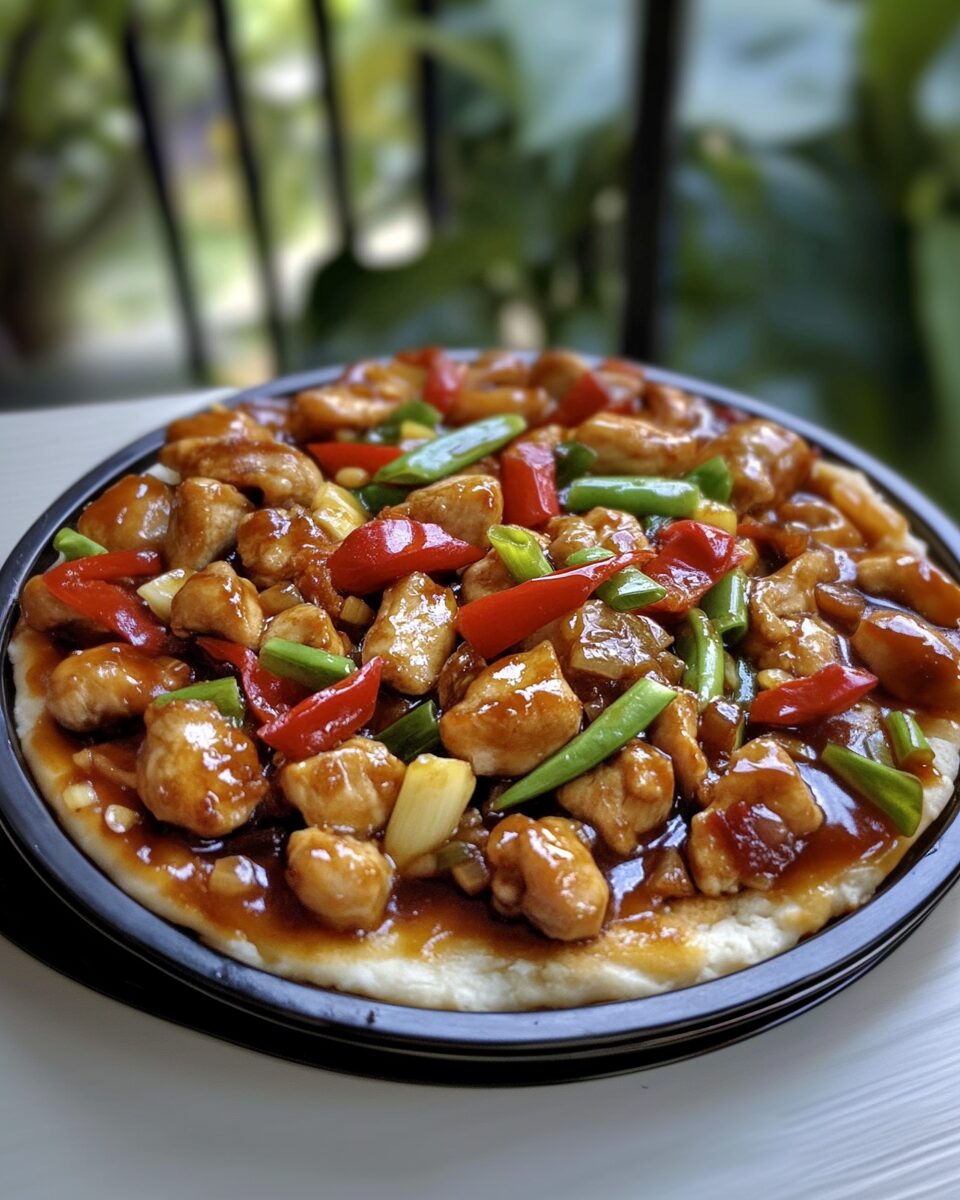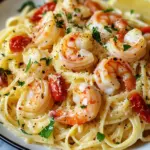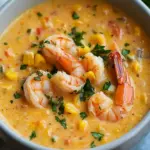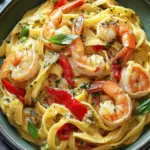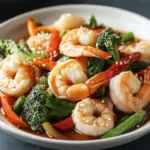Kung Pao Chicken is a classic Chinese stir-fry dish featuring juicy chicken cubes, roasted peanuts, and vibrant vegetables tossed in a spicy, tangy, and slightly sweet sauce. It’s quick, flavorful, and perfect for anyone craving bold Asian flavors. This dish strikes a delicious balance between heat and sweetness, making it an easy and satisfying dinner option that rivals any takeout.
Full Recipe:
Ingredients
- 1.5 pounds chicken thighs, cut into bite-sized pieces
- 3 tablespoons soy sauce, divided
- 1 tablespoon Shaoxing wine (or dry sherry)
- 2 teaspoons cornstarch
- 3 tablespoons hoisin sauce
- 1 tablespoon Chinese black vinegar (or balsamic vinegar)
- 1 tablespoon sugar
- 2 teaspoons sesame oil
- 1/2 teaspoon crushed red pepper
- 2 tablespoons oil
- 8-10 dried red chilies
- 1 red bell pepper, diced
- 1 green bell pepper, diced
- 1/2 cup roasted peanuts
- 5 scallions, chopped
- 3 cloves garlic, minced
- 1 tablespoon ginger, minced
Directions
- In a bowl, combine chicken pieces with 1 tablespoon soy sauce, Shaoxing wine, and cornstarch. Let it marinate for about 15 minutes.
- In another bowl, prepare the sauce by mixing hoisin sauce, black vinegar, sugar, sesame oil, crushed red pepper, and the remaining soy sauce.
- Heat oil in a wok or large skillet over medium-high heat. Add dried red chilies and cook for about 30 seconds.
- Add marinated chicken and stir-fry until browned and almost cooked through, about 4-5 minutes.
- Toss in the bell peppers, garlic, and ginger. Stir-fry for another 2-3 minutes.
- Add the sauce and mix well, cooking for another 2 minutes until everything is coated and heated through.
- Stir in peanuts and scallions. Give it a quick toss and remove from heat.
- Serve hot with steamed rice.
Nutrients
Per serving (based on 4 servings):
- Calories: 450 kcal
- Protein: 30g
- Fat: 28g
- Saturated Fat: 6g
- Carbohydrates: 22g
- Fiber: 3g
- Sugar: 8g
- Sodium: 950mg
The History and Origins of Kung Pao Chicken
The story behind Kung Pao Chicken is both rich and intriguing. The dish is named after a late Qing Dynasty official, Ding Baozhen, who was known as “Kung Pao” (meaning “Palace Guardian”). Legend has it that Ding was an enthusiastic cook who loved experimenting with different ingredients and flavors. During his time as governor of Sichuan province, he would frequently entertain guests with this delicious stir-fry, combining chicken, peanuts, and vegetables with a mix of spices to create a savory masterpiece.
Over time, the recipe spread beyond the confines of Ding’s household and gained popularity across China. It wasn’t long before it made its way to the United States, where Chinese immigrants brought their culinary traditions with them. In the U.S., Kung Pao Chicken evolved into a more accessible version, with restaurants adjusting the dish to cater to local tastes. Today, it’s a staple in Chinese-American cuisine, though variations of the dish can be found all over the world.
Key Ingredients and Flavor Profile
The magic of Kung Pao Chicken lies in its balance of flavors. The core ingredients of chicken, peanuts, and vegetables are simple, but it’s the combination of spices and sauces that makes this dish so irresistible.
The chicken is typically marinated to enhance its flavor and tenderness, while peanuts add a delightful crunch and nutty richness to each bite. Vegetables like bell peppers, onions, and scallions bring color and freshness to the dish, ensuring a satisfying contrast with the savory sauce. The sauce is made up of a carefully crafted mix of soy sauce, hoisin sauce, vinegar, sugar, and sesame oil, which imparts a deep umami flavor with hints of sweetness, tanginess, and mild heat.
For those who enjoy a bit of spice, dried red chilies are a crucial ingredient. They provide the heat that defines the dish, though they’re typically used in moderation, allowing the other flavors to shine. Sichuan peppercorns can also be added for an additional layer of flavor, giving the dish its characteristic numbing sensation that tingles on the tongue.
Cooking Techniques for a Perfect Kung Pao Chicken
While the recipe may seem simple, achieving the perfect balance of flavors in Kung Pao Chicken requires the right cooking techniques. Stir-frying is the traditional method used to prepare this dish, as it allows for quick cooking at high heat while preserving the textures and freshness of the ingredients.
The key to a successful stir-fry is to keep the ingredients moving constantly in the pan, ensuring they cook evenly and don’t burn. The oil should be heated to the right temperature before adding the ingredients, and the chicken should be cooked until it’s golden brown and tender. This ensures that the chicken absorbs all the flavors of the sauce while remaining juicy and flavorful.
To achieve the perfect sauce consistency, it’s essential to let the ingredients simmer for a few minutes to allow the flavors to meld together. The sauce should coat the chicken and vegetables, but not be overly thick or runny. Stir-frying over high heat ensures that the sauce is quickly absorbed into the ingredients without overpowering them.
Nutritional Benefits of Kung Pao Chicken
Kung Pao Chicken is not only delicious but also relatively nutritious. It’s a good source of protein from the chicken, making it a great option for those looking to maintain or build muscle. The dish also contains healthy fats from the peanuts, which are rich in monounsaturated fats and antioxidants. Peanuts have been linked to improved heart health and can help manage blood sugar levels, making them a beneficial addition to the recipe.
The vegetables in Kung Pao Chicken, including bell peppers and onions, contribute essential vitamins and minerals. Bell peppers are high in vitamin C, which supports immune health, while onions are a good source of fiber and antioxidants that can help reduce inflammation and promote digestive health.
However, as with any dish, it’s important to be mindful of the sauce’s sodium content, especially if you’re using store-bought soy sauce. To make the dish a bit healthier, consider using low-sodium soy sauce or adjusting the amount of sugar in the sauce to suit your preferences.
How to Customize Kung Pao Chicken
One of the great things about Kung Pao Chicken is that it’s highly customizable. While the classic version uses chicken, you can easily swap it out for other proteins such as shrimp, tofu, or even beef. If you prefer a vegetarian option, tofu or tempeh can provide a hearty substitute, absorbing the delicious sauce and offering a satisfying texture.
The level of spiciness can also be adjusted to suit your taste. If you like things milder, reduce the number of dried red chilies or remove them entirely. On the other hand, if you’re a fan of intense heat, you can add extra Sichuan peppercorns or chili flakes to give the dish an extra kick.
For those who want to make the dish more filling, you can add extra vegetables like broccoli, zucchini, or mushrooms. These additions will complement the flavors of the dish and provide additional nutrients without overwhelming the other ingredients.
Kung Pao Chicken in Popular Culture
Kung Pao Chicken has become such an iconic dish that it’s frequently featured in popular culture. Whether in movies, TV shows, or food blogs, this dish is often portrayed as a symbol of Chinese-American cuisine. Its popularity has also made it a go-to order at Chinese takeout restaurants, with many people considering it one of the must-try dishes when exploring Chinese cuisine.
Conclusion
Kung Pao Chicken is more than just a dish—it’s a flavorful journey into the heart of Chinese cuisine. From its historical origins in Sichuan to its widespread popularity around the world, this dish showcases the perfect balance of sweet, savory, and spicy flavors. Whether you’re cooking it at home for the first time or enjoying it at your favorite restaurant, Kung Pao Chicken promises a satisfying meal that’s sure to please your taste buds.

